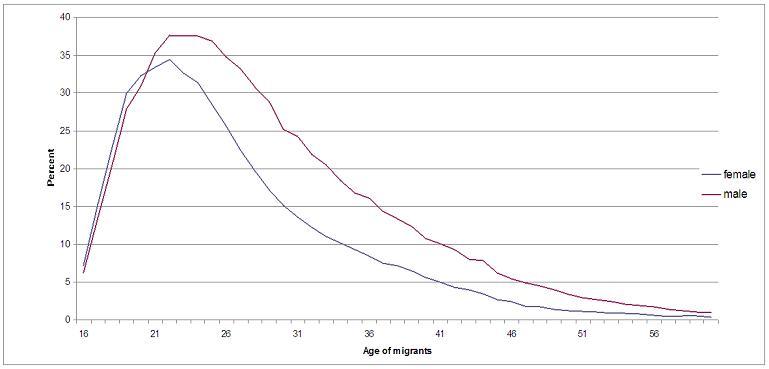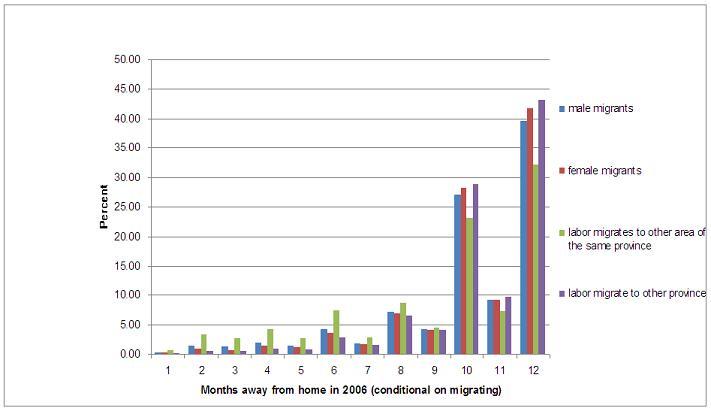China is experiencing the largest internal migration in human history. In 1990, over 34 million workers left their rural homes in search of urban jobs. This number increased to 67 million in 1999 and nearly 135 million in 2005. While rural-to-urban migration is one of the most important drivers for economic growth (Young 2003), the massive migration has touched the life of Chinese people in many other ways.
Due to residence permit and other institutional barriers in China, most migrating workers leave their families in the village and travel between rural home and urban jobs every year. Not only does this create traffic congestion around the Spring Festival, anecdotes suggest that rural migrants take the most dirty and dangerous jobs in the city but have the least labour protection; many migrants carry their annual earnings in cash only to become the target of theft on the way home; some rural children grow up with physical and social problems because their parent(s) are far away; and the elderly have to fill in as the guardian of grandchildren and farm the land for the whole family.
In a recent working paper (Chen et al. 2010), we examine the determinants of migration. Classical theories argue that an individual will migrate if the discounted present value of income gains exceeds the direct cost of migration (Sjaastad 1962). These models emphasise geographic attributes (e.g. distance to destination), individual characteristics (e.g. age and education), and market factors (e.g. wage gap and land ownership). More recently, economists have stressed the role of social networks in job markets and extended the idea to labour migration (see Ioannides and Loury 2004 for a detailed review). As modelled in Carrington et al. (1996), if earlier migrants help later migrants by reducing the cost of moving to the same destination, migration may occur gradually but develop momentum over time. This explains why migration tends to cluster geographically and why migratory flows may increase even as wage differentials narrow.
Using the 2006 China Agricultural Census, we examine the role of social networks in migration while controlling for observed and unobserved factors at the individual level. Previous researchers have done similar exercise for Mexican migrants (Munshi 2003, Mckenzie and Rapoport 2007), but since their data only cover 57 communities and 200 households per community, it is difficult to quantify the strength of social networks within a community. In contrast, our data aim to cover everyone who has a residential permit (hukou) in a continuous rural area, including those who have migrated for remote jobs. In total, we observe 5.9 million individuals in 3950 villages that belong to 250 townships within 8 counties. Among the 3.3 million adults that are available for work, 17% choose to migrate for urban jobs and they are more likely to be young, male, relatively better educated, and from a household with fewer young children, fewer contract land, but close to a bus station. Figure 1 shows the percentage of adults that migrate by age and gender in our sample, where an individual is defined as migrant if he or she has been away from the village for the reason of work for more than 15 days in 2006. Figure 2 shows that most migrants are away from home for more than 8 months a year.
Figure 1. Percentage of adults that migrate in 2006 by age and gender, study sample
Figure 2. Distribution of migrants by # of months away from home in 2006, study sample
Because many agricultural, governmental, and social activities are organised at the village level, the Chinese village is a natural host of social networks. When a villager migrates to the city and comes back for holiday or family visit, the information he has about the destination spreads out fast to others in the same village. Given the fact that many Chinese cities impose barriers to entry for rural migrants, knowing someone at the destination also implies a lower moving cost.
These social-network arguments suggest that migrants should cluster by village. In line with this, we observe the migration rate varies greatly across the 3950 villages in our sample (0% to 50%) but village-level observables explain only 57.8% of the cross-village variation. We find that migrants from the same village tend to cluster at the same destination for the same occupation (Table 1). If we single out the most common occupation within each village, 75.1% of same-village migrants work in that occupation. This number is much higher than what we will get by township (51.93%), county (46.12%) or the whole area (46.48%). Similarly, the percentage of migrants to the most common destination is more concentrated by village (63.8%) than by township (39.82%), county (31.86%), or the whole area (27.86%). These statistics support the idea that each village is a closely-knit social network and people interact with each other much more within the village than across villages. Given the facts that the average area per village is only 4 km2 and villages in the same township are adjacent by definition, the migration clusters shown here are similar to the employment clusters documented in Bayer et al. (2008).
Table 1. Within-village cluster of migrants by destination and occupation
| |
average
by village
|
average
by township
|
average
by county
|
Whole area
|
|
% of migrants in the most common occupation
|
75.10%
|
51.93%
|
46.21%
|
46.68%
|
|
|
(0.68%)
|
(1.00%)
|
(1.71%)
|
|
|
% of migrants in the most common destination
|
63.80%
|
39.82%
|
31.66%
|
27.86%
|
|
|
(0.76%)
|
(0.84%)
|
(4.54%)
|
|
|
% in the most common occupation, conditional on migrants in the most common destination
|
83.80%
|
59.07%
|
54.27%
|
59.05%
|
|
|
(0.59%)
|
(1.12%)
|
(5.90%)
|
|
|
% in the most common occupation of each destination
|
95.20%
|
58.33%
|
49.83%
|
47.63%
|
|
|
(0.34%)
|
(0.81%)
|
(3.26%)
|
|
|
No. of units
|
3950
|
250
|
8
|
1
|
Standard error in parentheses.
Of course, a cluster of economic actions does not necessarily imply that one’s action affects the action of other people in the same network (Manski 1993). Clustered migration may be driven by villagers having similar individual characteristics or facing similar institutional environments. Even if we rule out these correlated effects, the migration decision of one villager may add peer pressure on non-migrants or create general equilibrium effects within the village, both of which could influence the migration of other villagers directly.
To distinguish these alternative explanations from the role of social networks in information and cost sharing, we use China’s one-child policy to construct individual-level instruments. In particular, the one child policy allows rural households to have a second baby if the first child is a girl. Not only does this policy minimise sex selection on the oldest child of a household, it also implies that rural households with a girl firstborn are more likely to have a second child. Under the assumption that one’s family size and gender composition of children do not directly affect the migration decision of neighbouring households in the same village, their influence in neighbours’ migration decision can be interpreted as social interactions. We argue our individual-level instruments are more informative than the village-level instruments used in the literature, because village-level variables such as rainfall in the sending community (Munshi 2003) could affect both peer and self migration and therefore does not identify how peer migration affects one’s own migration decision.
After constructing instruments based on the sex of neighbours’ firstborns and whether neighbours’ first birth is multiples, we find that one percentage point increase in the percentage of neighbours migrating out of a village will increase one’s own migration probability by 0.727 percentage points. If we ignore other long run considerations (say ageing), simulations suggest that a village starting with 1% of migration in the first year will reach a migration rate of 6% by the fifth year and over 60% by the eleventh year.
The instruments help identify social interactions within a village, but the quest remains whether they arise because people use the village-wide social network to reduce moving cost and obtain job information, or because of peer pressure and general equilibrium effects at the origin? Evidence suggests the former is more likely, as migrants from the same village tend to cluster at the same destination for the same occupation, and the strength of social interactions is greater for the origins that are more difficult to travel from and more deprived of job information. After ruling out organised migration as another alternative explanation, we conclude that social network effects are the dominant force driving the migration clusters.
Implications
Clustered migration could have large, persistent, and sometimes alarming implications for socio-economic issues. For example, the traffic between a migration origin and a migration destination is likely clustered, which could create serious congestion on specific routes even if the overall market is not crowded. Another implication is significant demographic change in high-migration villages. Since migrants are more likely to be male, young, and better educated (and the social network effects are the strongest among similar age and gender), the remaining population of high-migration villages is likely to be concentrated in children, women, and the elderly. These demographic changes could have profound impacts on agricultural productivity, child development, education, and elderly care. Lastly, clustered migration creates a strong link between origin and destination. Take the on-going economic recession for example. Since a large fraction of migrants are concentrated in export-oriented manufacturing, the reduced international demand in 2008 and the subsequent return of unemployed labour has created serious problems for inland provinces. This problem could be worsened by clustered migration because it reduces the origin’s ability to diversify the macroeconomic risk.
References
Bayer, Patrick, Stephen L Ross and Giorgio Topa (2008), "Place of Work and Place of Residence: Informal Hiring Networks and Labour Market Outcomes", Journal of Political Economy, 116(6):1150-1196, December.
Carrington, William J, Enrica Detragiache and Tara Vishwanath (1996), “Migration with Endogenous Moving Costs”, American Economic Review, 86(4):909-30.
Chen, Yuyu, Ginger Zhe Jin and Yang Yue (2010), “Peer Migration in China”, NBER working paper 15671.
Ioannides, Yannis and Linda Datcher Loury (2004), "Job Information Networks, Neighborhood Effects and Inequality", Journal of Economic Literature 42(4):1056-1093.
Manski, Charles F (1993), “Identification of Endogenous Social Effects: The Reflection Problem”, Review of Economic Studies, 60:531-542.
Mckenzie, David and Hillel Rapoport (2007), “Network Effects and the Dynamics of Migration and Inequality: Theory and Evidence from Mexico”, Journal of Development Economics, 84: 1-24.
Munshi, Kaivan (2003), “Networks in the Modern Economy: Mexican Migrants in the U.S. Labour Market”, Quarterly Journal of Economics, 118(2):549-600.
Sjaastad , Larry A (1962), “The Costs and Returns of Human Migration”, The Journal of Political Economy, 1962, 70(S5):80-93.
Young, Alwyn (2003), “Gold into Base Metals: Productivity Growth in the People’s Republic of China during the Reform Period”, Journal of Political Economy, Vol 111(6).





